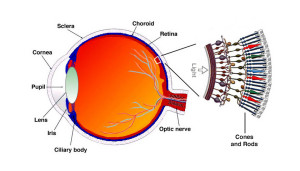Blue Cone Monochromacy (BCM) is a rare genetic disease of the retina that almost exclusively affects males (with an incidence of 1 in 100,000 individuals). It is a hereditary condition, and manifests itself with a partial dysfunction of the cones of the retina linked to the X chromosome. It causes a loss of visual acuity, photophobia, myopia (in many cases) and infantile nystagmus, which sometimes persists into adulthood. Colour vision is severely impaired from birth, with the residual capacity permitted by the blue cones and the rods. The back of the eye appears normal yet in rare cases in older adults macular atrophy can occur.
| Names |
BCM, Blue Cone Monochromacy, Blue Cone Monochromatism |
| Symptoms |
– impaired vision or poor visual acuity, between 20/200 and 20/63 (poor detail vision);
– intolerance to light (photophobia);
– poor ability or inability to distinguish colours;
– infantile nystagmus, which in some cases persists into adulthood (involuntary rhythmical, repetitive eye movement);
– myopia, severe myopia or other refractive errors; |
| Other features |
– the retina has a normal appearance;
– stable condition, present from birth and non-progressive but in some older adults a progressive central retinal atrophy is observed;
– abnormal or no photopic ERG; |
| Scientific references |
OMIM 303700 |
| Genetic transmission and Genes |
X-linked recessive
location: Xq28
Genes: OPN1LW, OPN1MW |
|

BCM affects cone in the eye’s retina.

A child with BCM: low vision force him to write very close to the paper.
|
You find a description of BCM symptoms (photophobia, nystagmus, low vision) in the following video:

